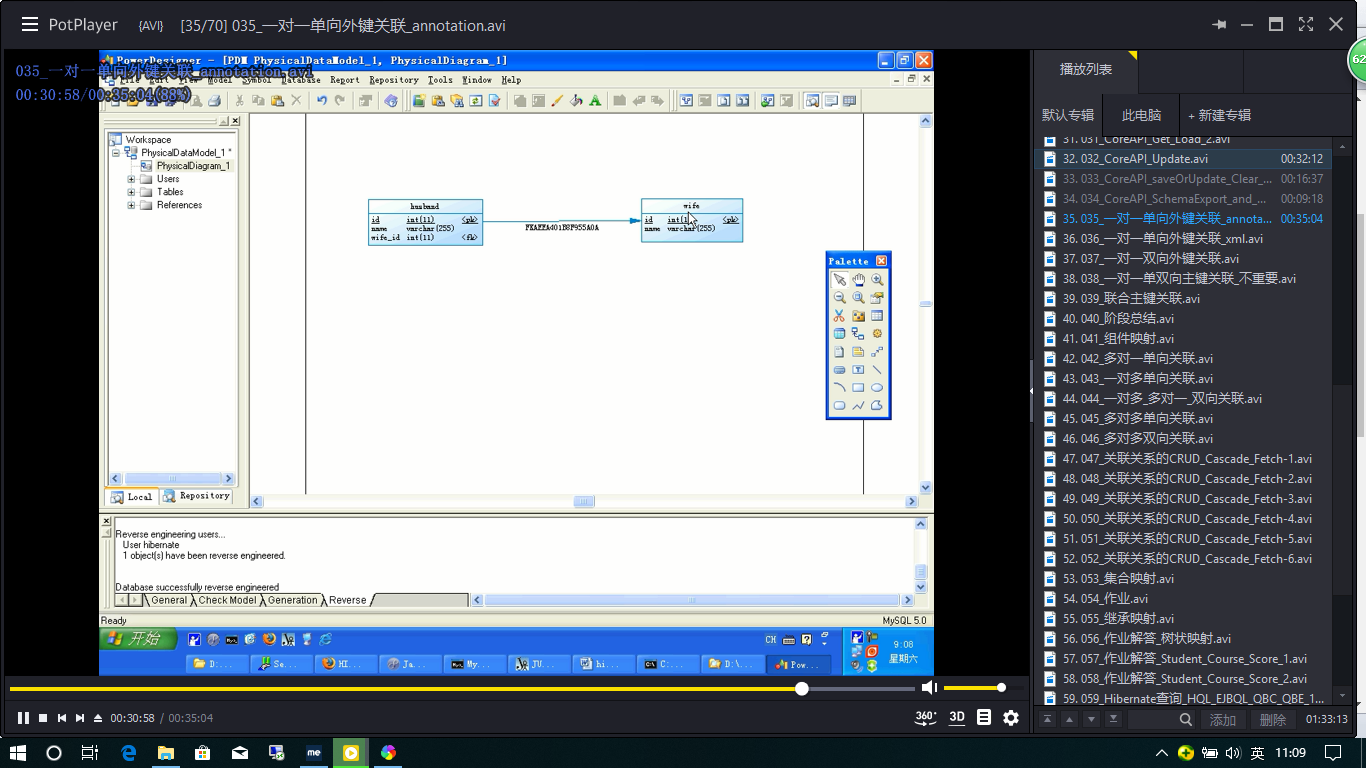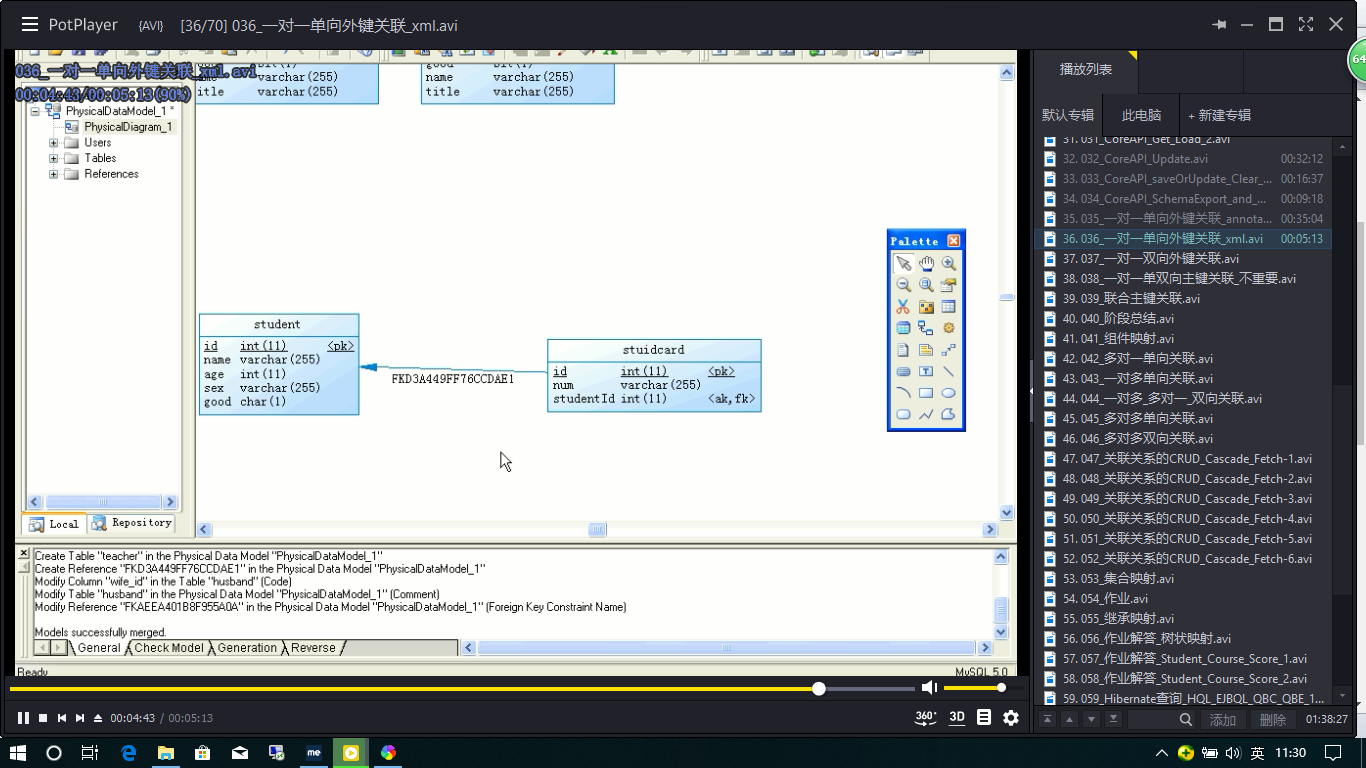主要指对象之间的关系
1.一对一关联
一对一单项外键关联
比如说一夫一妻
Wifi.java
package com.bjsxt.hibernate; import javax.persistence.Entity; import javax.persistence.GeneratedValue; import javax.persistence.Id; @Entity public class Wife { private int id; private String name; @Id @GeneratedValue public int getId() { return id; } public void setId(int id) { this.id = id; } public String getName() { return name; } public void setName(String name) { this.name = name; } }
Huaband.java
package com.bjsxt.hibernate; import javax.persistence.Entity; import javax.persistence.GeneratedValue; import javax.persistence.Id; import javax.persistence.JoinColumn; import javax.persistence.OneToOne; @Entity public class Husband { private int id; private String name; private Wife wife; @Id @GeneratedValue public int getId() { return id; } public String getName() { return name; } @OneToOne @JoinColumn(name="wifeId") public Wife getWife() { return wife; } public void setId(int id) { this.id = id; } public void setName(String name) { this.name = name; } public void setWife(Wife wife) { this.wife = wife; } }
hibernate.cfg.xml
<?xml version='1.0' encoding='utf-8'?> <!DOCTYPE hibernate-configuration PUBLIC "-//Hibernate/Hibernate Configuration DTD 3.0//EN" "http://hibernate.sourceforge.net/hibernate-configuration-3.0.dtd"> <hibernate-configuration> <session-factory> <property name="connection.driver_class">com.mysql.jdbc.Driver</property> <property name="connection.url">jdbc:mysql://localhost/hibernate</property> <property name="connection.username">root</property> <property name="connection.password">bjsxt</property> <property name="dialect">org.hibernate.dialect.MySQLDialect</property> <!-- <property name="connection.driver_class">oracle.jdbc.driver.OracleDriver</property> <property name="connection.url">jdbc:oracle:thin:@localhost:1521:SXT</property> <property name="connection.username">scott</property> <property name="connection.password">tiger</property> <property name="dialect">org.hibernate.dialect.OracleDialect</property> --> <!-- JDBC connection pool (use the built-in) --> <property name="connection.pool_size">1</property> <!-- Enable Hibernate's automatic session context management --> <property name="current_session_context_class">thread</property> <!-- Disable the second-level cache --> <property name="cache.provider_class">org.hibernate.cache.NoCacheProvider</property> <!-- Echo all executed SQL to stdout --> <property name="show_sql">true</property> <property name="format_sql">true</property> <!-- Drop and re-create the database schema on startup <property name="hbm2ddl.auto">update</property> --> <!-- --> <mapping resource="com/bjsxt/hibernate/Student.hbm.xml"/> <mapping resource="com/bjsxt/hibernate/StuIdCard.hbm.xml"/> <mapping class="com.bjsxt.hibernate.Husband"/> <mapping class="com.bjsxt.hibernate.Wife"/> </session-factory> </hibernate-configuration>
test.java关键代码
@Test public void testSchemaExport() { new SchemaExport(new AnnotationConfiguration().configure()).create(false, true); }
实际建表关系

@OneToOne @JoinColumn(name="wifeId") public Wife getWife() { return wife; } public void setId(int id) { this.id = id; }
上面可以指定生成的列名
2.单向关联
Student.java
package com.bjsxt.hibernate; public class Student { private int id; private String name; private int age; private String sex; private boolean good; public boolean isGood() { return good; } public void setGood(boolean good) { this.good = good; } public int getId() { return id; } public void setId(int id) { this.id = id; } public String getName() { return name; } public void setName(String name) { this.name = name; } public int getAge() { return age; } public void setAge(int age) { this.age = age; } public String getSex() { return sex; } public void setSex(String sex) { this.sex = sex; } }
StuIdCard.java
package com.bjsxt.hibernate; public class StuIdCard { private int id; private String num; private Student student; public int getId() { return id; } public void setId(int id) { this.id = id; } public String getNum() { return num; } public void setNum(String num) { this.num = num; } public Student getStudent() { return student; } public void setStudent(Student student) { this.student = student; } }
StuIdCard.hbm.xml
<?xml version="1.0"?> <!DOCTYPE hibernate-mapping PUBLIC "-//Hibernate/Hibernate Mapping DTD 3.0//EN" "http://hibernate.sourceforge.net/hibernate-mapping-3.0.dtd"> <hibernate-mapping> <class name="com.bjsxt.hibernate.StuIdCard"> <id name="id"> <generator class="native"></generator> </id> <property name="num"/> <many-to-one name="student" column="studentId" unique="true"></many-to-one> </class> </hibernate-mapping>
从字面上看是多对一 其实后面指定了unique 所以实际上是一对一
关系图

2.一对一双向外键关联
直接写@onetoone的话会导致产生两个外键
Husband.java
package com.bjsxt.hibernate; import javax.persistence.Entity; import javax.persistence.GeneratedValue; import javax.persistence.Id; import javax.persistence.JoinColumn; import javax.persistence.OneToOne; @Entity public class Husband { private int id; private String name; private Wife wife; @Id @GeneratedValue public int getId() { return id; } public String getName() { return name; } @OneToOne @JoinColumn(name="wifeId") public Wife getWife() { return wife; } public void setId(int id) { this.id = id; } public void setName(String name) { this.name = name; } public void setWife(Wife wife) { this.wife = wife; } }
Wife.java
package com.bjsxt.hibernate; import javax.persistence.Entity; import javax.persistence.GeneratedValue; import javax.persistence.Id; import javax.persistence.OneToOne; @Entity public class Wife { private int id; private String name; private Husband husband; @OneToOne(mappedBy="wife") //在对方那里设置 public Husband getHusband() { return husband; } public void setHusband(Husband husband) { this.husband = husband; } @Id @GeneratedValue public int getId() { return id; } public void setId(int id) { this.id = id; } public String getName() { return name; } public void setName(String name) { this.name = name; } }
只要有双向关联,必须设@OneToOne(mappedBy="wife")
告诉hibernate对方那里是主导
2.XML设置
Student.hbm.xml
<?xml version="1.0"?> <!DOCTYPE hibernate-mapping PUBLIC "-//Hibernate/Hibernate Mapping DTD 3.0//EN" "http://hibernate.sourceforge.net/hibernate-mapping-3.0.dtd"> <hibernate-mapping> <class name="com.bjsxt.hibernate.Student" dynamic-update="true"> <id name="id"> <generator class="native"></generator> </id> <property name="name"></property> <property name="age" /> <property name="sex" /> <property name="good" type="yes_no"></property> <one-to-one name="stuIdCard" property-ref="student"></one-to-one> </class> </hibernate-mapping>
一对一单向双向的区别:在数据库没什么区别 但是在Java程序中有区别 单向和双向的区别能否靠对方找到自己
4.一对一单向主键关联
Husband.java
package com.bjsxt.hibernate; import javax.persistence.Entity; import javax.persistence.GeneratedValue; import javax.persistence.Id; import javax.persistence.JoinColumn; import javax.persistence.OneToOne; import javax.persistence.PrimaryKeyJoinColumn; @Entity public class Husband { private int id; private String name; private Wife wife; @Id @GeneratedValue public int getId() { return id; } public String getName() { return name; } @OneToOne @PrimaryKeyJoinColumn public Wife getWife() { return wife; } public void setId(int id) { this.id = id; } public void setName(String name) { this.name = name; } public void setWife(Wife wife) { this.wife = wife; } }
wifi.java
package com.bjsxt.hibernate; import javax.persistence.Entity; import javax.persistence.GeneratedValue; import javax.persistence.Id; @Entity public class Wife { private int id; private String name; @Id @GeneratedValue public int getId() { return id; } public void setId(int id) { this.id = id; } public String getName() { return name; } public void setName(String name) { this.name = name; } }
测试
@Test public void testSchemaExport() { new SchemaExport(new AnnotationConfiguration().configure()).create(false, true); }
但实际上并没有产生关联 这是一个bug
在xml里面配置正常
StuIdCard.hbm.xml
<?xml version="1.0"?> <!DOCTYPE hibernate-mapping PUBLIC "-//Hibernate/Hibernate Mapping DTD 3.0//EN" "http://hibernate.sourceforge.net/hibernate-mapping-3.0.dtd"> <hibernate-mapping> <class name="com.bjsxt.hibernate.StuIdCard"> <id name="id"> <generator class="foreign"> <param name="property">student</param> </generator> </id> <property name="num"/> <one-to-one name="student" constrained="true"></one-to-one> </class> </hibernate-mapping>
constrained = “true” 就可以加一个外键约束
在实际开发中,一对一很少,一对一主键也很少
一对一双向主键关联 不太重要 一般不使用 略
联合主键
Husband.java
package com.bjsxt.hibernate; import javax.persistence.Entity; import javax.persistence.GeneratedValue; import javax.persistence.Id; import javax.persistence.JoinColumn; import javax.persistence.JoinColumns; import javax.persistence.OneToOne; @Entity public class Husband { private int id; private String name; private Wife wife; @Id @GeneratedValue public int getId() { return id; } public String getName() { return name; } @OneToOne @JoinColumns( { @JoinColumn(name="wifeId", referencedColumnName="id"), @JoinColumn(name="wifeName", referencedColumnName="name") } ) public Wife getWife() { return wife; } public void setId(int id) { this.id = id; } public void setName(String name) { this.name = name; } public void setWife(Wife wife) { this.wife = wife; } }
Wife.java
package com.bjsxt.hibernate; import javax.persistence.Entity; import javax.persistence.Id; import javax.persistence.IdClass; @Entity @IdClass(WifePK.class) public class Wife { private int id; private String name; private int age; public int getAge() { return age; } public void setAge(int age) { this.age = age; } @Id public int getId() { return id; } public void setId(int id) { this.id = id; } @Id public String getName() { return name; } public void setName(String name) { this.name = name; } }
WifePK.java
package com.bjsxt.hibernate; import java.io.Serializable; public class WifePK implements Serializable { private int id; private String name; public int getId() { return id; } public void setId(int id) { this.id = id; } public String getName() { return name; } public void setName(String name) { this.name = name; } }
hibernate.cfg.xml
<?xml version='1.0' encoding='utf-8'?> <!DOCTYPE hibernate-configuration PUBLIC "-//Hibernate/Hibernate Configuration DTD 3.0//EN" "http://hibernate.sourceforge.net/hibernate-configuration-3.0.dtd"> <hibernate-configuration> <session-factory> <property name="connection.driver_class">com.mysql.jdbc.Driver</property> <property name="connection.url">jdbc:mysql://localhost/hibernate</property> <property name="connection.username">root</property> <property name="connection.password">bjsxt</property> <property name="dialect">org.hibernate.dialect.MySQLDialect</property> <!-- <property name="connection.driver_class">oracle.jdbc.driver.OracleDriver</property> <property name="connection.url">jdbc:oracle:thin:@localhost:1521:SXT</property> <property name="connection.username">scott</property> <property name="connection.password">tiger</property> <property name="dialect">org.hibernate.dialect.OracleDialect</property> --> <!-- JDBC connection pool (use the built-in) --> <property name="connection.pool_size">1</property> <!-- Enable Hibernate's automatic session context management --> <property name="current_session_context_class">thread</property> <!-- Disable the second-level cache --> <property name="cache.provider_class">org.hibernate.cache.NoCacheProvider</property> <!-- Echo all executed SQL to stdout --> <property name="show_sql">true</property> <property name="format_sql">true</property> <!-- Drop and re-create the database schema on startup <property name="hbm2ddl.auto">update</property> --> <!-- --> <mapping class="com.bjsxt.hibernate.Husband"/> <mapping class="com.bjsxt.hibernate.Wife"/> </session-factory> </hibernate-configuration>
Test
package com.bjsxt.hibernate; import java.util.Date; import org.hibernate.Query; import org.hibernate.Session; import org.hibernate.SessionFactory; import org.hibernate.cfg.AnnotationConfiguration; import org.hibernate.tool.hbm2ddl.SchemaExport; import org.junit.AfterClass; import org.junit.BeforeClass; import org.junit.Test; public class HibernateORMappingTest { private static SessionFactory sessionFactory; //@BeforeClass public static void beforeClass() { sessionFactory = new AnnotationConfiguration().configure().buildSessionFactory(); } //@AfterClass public static void afterClass() { sessionFactory.close(); } @Test public void testSchemaExport() { new SchemaExport(new AnnotationConfiguration().configure()).create(false, true); } public static void main(String[] args) { beforeClass(); } }